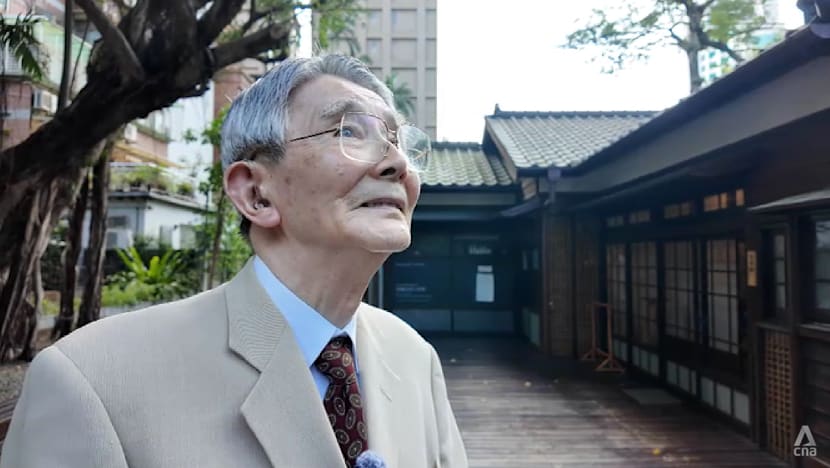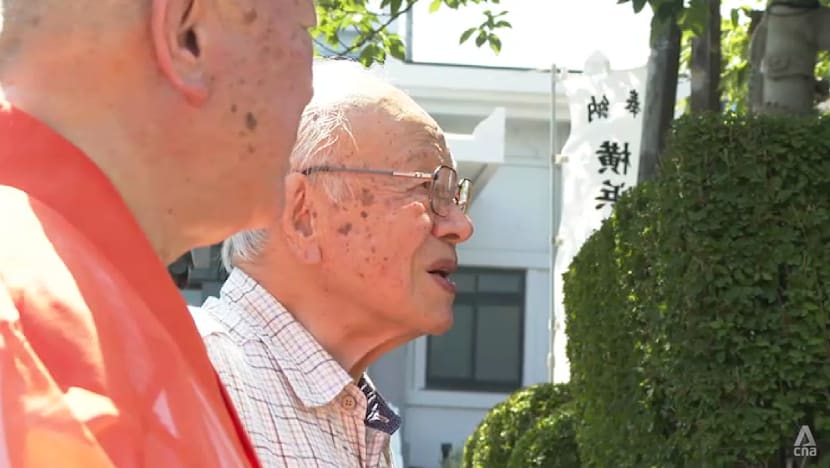The last surviving generation born during Japan’s colonisation of Taiwan
Japan’s 50-year rule that ended after World War II left behind not just an architectural legacy, but also complex emotions surrounding identity.

93-year-old Hisashi Niimoto is one of an estimated 200,000 people known as "wansei", a group of Japanese born in Taiwan during Japan's colonisation. They were repatriated after Japan's surrender in World War II.

This audio is generated by an AI tool.
In Taipei, Japanese-era architecture remains part of the cityscape.
Landmarks such as the Presidential Office Building are remnants of Japan’s colonial rule from 1895 to 1945, when as many as one in three Taipei residents were Japanese. Education was in Japanese, and districts were modelled after Japan's.
Zhongzheng district, for instance, was once a dormitory cluster for Japanese civil servants. It is now protected under Taiwan's Cultural Heritage Preservation Act.
It was also home to 93-year-old Hisashi Niimoto when he was living in Taipei.
Niimoto is one of an estimated 200,000 people known as "wansei", a group of Japanese born in Taiwan during Japan's colonisation. They were repatriated after Japan's surrender in World War II.
Though it happened 80 years ago, some of the last surviving wansei – then just children or teenagers – still see the island as a second home.
“Taiwan is where my grandfather and father lived. It is my birthplace,” said Niimoto.
JAPAN’S COLONISATION OF TAIWAN
During Japan’s 50-year colonisation of Taiwan, the island was treated as a subordinate territory. Policies aimed at assimilation were carried out and uprisings were brutally suppressed.
The 1915 Tapani incident was one of the largest armed revolts by Taiwanese Han and Aboriginals against Japanese rule in the territory.
Thousands were reportedly killed. Nearly 2,000 were arrested, with close to a hundred executed, according to official data.
At the same time, the colonial era also saw the development of key infrastructure such as roads and railways, as well as the transformation of the island’s economy.
Niimoto's grandfather, Shikanosuke, arrived in 1896 to oversee the building of the local railway, which grew to power Taiwan's economic development.
His father, Yatsuo, started a sugar cane plantation in Tainan as an employee of Meiji, then a new sugar manufacturer. During this period, Taiwan's sugar industry modernised and flourished, and Japanese firms came to dominate the market.
Japan's entry into World War II, and the subsequent Allied air raids on Taiwan - seen as strategically vital to Japan - changed the lives of those on the island.
WAR AND EXPULSION
Speaking to CNA from his home in Tokyo, where he now lives, Niimoto still vividly recalls the Allied bombing of Taipei on 31 May, 1945.
That day, an estimated 3,000 people were killed in air raids. Infrastructure was destroyed and buildings were flattened.
"Taipei Junior High School’s 200 students happened to be on the other side of Danshui River,” said Niimoto.
“We were on a mission to dig and create an anti-aircraft gun zone ... The air raid alarm went off. We heard boom, boom. Bombs dropped on the Office of the Governor-General.
“Then, we were allowed into a bomb shelter. When the last of the 200 entered and shut the lid, a 500kg bomb dropped on the entrance of the shelter.”
He added that the earth "turned upside down with a blast", and everything happened so quickly that they did not have time to think about death.
When Niimoto and his schoolmates emerged, they found a 20m-deep crater and the bodies of soldiers scattered around it.
Just 13 or 14 years old at the time, the incident fired up the resolve of young Niimoto, who had been taught - like many Japanese - to respect the military.
"I saw my teacher and told him I wanted to become a soldier. I was a pro-military kid then. Since I had a bicycle, I was ordered to join the bike messenger corps," said Niimoto.
But Niimoto was still too young to enlist. Soon after, Japan lost the war, and the order came that all Japanese had to leave Taiwan.
His father was told to stay and hand over his sugar cane business to the new government.
The rest of the family left Taiwan in 1946 - a year before his father - carrying only a case and a bag of belongings each. Niimoto's bag was filled with yokan, a sugary confection that, to him, captured the taste of childhood.
Niimoto's grandfather bought a house in Tokyo, but like other wansei who returned as outsiders to Japan, the family struggled financially.
Niimoto took a part-time job with the US occupation forces, while his mother sewed for a sheltered workshop.
Another wansei, Susumu Ito, now 83, remembers how his family fled deep into central Taiwan after the deadly air raids on Taipei to escape further bombings. When they returned to Taipei, a deportation order was issued.
"My father tried to take me to church by bicycle. Along the main road, there were soldiers of (former Chinese leader) Chiang Kai-shek. They were watching the area. It was tense,” said Ito.
His family boarded a ship back to Japan in 1947, alongside other Japanese, when Ito was just four years old.
REMNANTS OF THE COLONIAL ERA
Niimoto returned to Taiwan for the first time only in 1987 - the year its government lifted its nearly four-decade-long martial law. He said he found his former Taipei home occupied by the Kuomintang.
Public facilities and homes left behind by the Japanese after World War II were requisitioned by the postwar government, said researcher Huang Chih-huei from Academia Sinica's Institute of Ethnology, who has been campaigning to conserve colonial-era houses for two decades.
"For a short period of two to three years, in such (Japanese-occupied) areas in Taipei, there was no one. They were all vacated homes,” said Huang.
“But in 1949, due to civil war in the mainland … more than one million people arrived in Taiwan. At that time, the vacated homes left by the Japanese were ideal to house them.”
Many of these wooden houses were abandoned again after their new occupants died, and were left to decay. Others were razed to make way for redevelopment.
It was only in recent decades that some were repurposed.
“A bidding system (for such houses) was put in place. After renovation and repair, they (successful bidders) pay a monthly rent," said Huang.
Niimoto's Taipei home, which laid in ruins for years, has since been restored and turned into a cafe.
But development pressures and the passage of time continue to threaten these old houses.
Ito's father's home was demolished last year, despite a petition to conserve it. His mother's home, approved for preservation in 2023, remains empty and crumbling.
He made a trip back in May to visit his childhood home for what could be his last chance.
These homes carry both architectural and historical significance, said Huang.
"It is not just about family history," he noted. "It is about Taiwan, Taipei’s history until today. It is one page that cannot be omitted."
For some Taiwanese, Japanese colonisation is remembered as a period of progress and prosperity. For others, it is marked by repression, control and violence.
Chung Shu-min, director of the Institute of Taiwan History at Academia Sinica, said it is difficult to define which was greater - the oppression or the progress made during this era, a period when key infrastructure such as roads and railways were built, and healthcare improved.
“For ordinary people in Taiwan, of course it was a disaster, of course it was a form of oppression. But from the perspective of Taiwan’s economic development, there may have also been some positive aspects," said Chung.
PERCEPTIONS OF IDENTITY
Ninety-seven-year-old Taiwanese Lu Rong-mao, whose Japanese name is Shigeo Miyakawa, remembers the Japanese as being helpful to poor households in Taiwan.
"My parents were originally from Hsinchu city and were very poor, but later, we became wealthy," he said.
He belongs to the generation of Taiwanese born during the colonial era who learned Japanese and identified as Japanese - so much that he volunteered to join the military and defend the colony near the end of World War II, as Japan's defeat loomed.
More than 200,000 Taiwanese served in the Imperial Japanese Army during the war. Of these, an estimated 30,000 never returned home.
Yang Fu-cheng was barely 21 when he signed up in 1943.
"I thought that for a Japanese citizen, if Japan is at war, then I should participate," said the 104-year-old.
He was sent to Singapore - not to fight on the frontlines, but to organise supplies for Japan’s vast military network. There, he was treated like any other Japanese soldier, he said.
"I was even given the keys to the vault. He (my Japanese commander) trusted me a lot. At that time, he said, ‘You are Taiwanese, so of course you are a Japanese soldier.’ I immediately changed my name to be in Japanese," said Yang.
After Japan’s surrender, Yang’s commander offered him a life in Tokyo. Instead, he chose to return to a very different Taiwan.
"There was the 228 Incident, when mainlanders came to Taiwan and killed people indiscriminately," said Yang.
Taiwan's government has since apologised. But not before Yang spent seven years in prison during the White Terror - a period of political repression.
A TAIWANESE VETERAN'S WISH
Taiwanese Masao Go, 98, was one of the youngest to serve in the Japanese military during World War II. As far as he knows, he is the sole survivor from his unit.
In 1941, his father sent him to Tokyo to attend junior high, where he went by the name Masao Oyama. Inspired by daily reports of Japan’s military successes, he enrolled in a military training school at the age of 16 in 1944.
Then, air raids began, and they were ordered to relocate to North Korea to train.
Masao set his sights on becoming a suicide pilot, as his feelings of patriotism and sacrifice grew. But he was not accepted and never fought on the frontlines.
"They rejected eldest sons. Those who were chosen departed on 5 Aug, (1945). That was 10 days before the war ended,” said Masao.
After Japan surrendered, he was taken hostage by the Soviet Army and sent to a labour camp in what is now Kazakhstan.
37,000 soldiers from the Japanese army were subjected to forced labour in Kazakhstan, according to Japan's health ministryAround 1,500 of them died.
Masao was repatriated to Japan in 1947.
Yet the fate of his fellow soldiers weighed heavily on him. In particular, he longed for a way to mourn the Taiwanese who died in service.
“The Japanese built memorials for former Japanese soldiers.... But there was none for the Taiwanese war dead. I did hear there was one in the mountains of Okutama (in Tokyo). But I have never seen it."
In December last year, Masao approached the chief resident abbot of Zen Mazan Shinsyouji Temple in Yokohama, Eikan Mizutani, about erecting a memorial. The abbot agreed, and the memorial was completed in April.
"It was not taught in Japanese education. So I was even more motivated to build the cenotaph. I want the general public to know (about Taiwanese soldiers),” said Mizutani.

EMBELLISHED MEMORIES?
Japan committed numerous war crimes during World War II, from massacres to torture and forced labour.
Its occupation is widely condemned, and the period in history continues to strain diplomatic relations with neighbours such as China and South Korea.
For Taiwan, which was a Japanese colony for 50 years and where generations were brought up to identify as Japanese subjects, emotions surrounding Japanese rule are complex.
Academia Sinica’s Chung noted that the colonial period was followed by a painful chapter in Taiwanese history - the White Terror, marked by martial law and political repression.
"After the Kuomintang government came to Taiwan, much of the oppression the Japanese government had previously inflicted on Taiwan continued. For example, between mainlanders and local Taiwanese, Taiwanese were put down at the bottom of society," said Chung.
"After the White Terror, I think many people, having personally experienced it, have likely embellished their memories of Japan.”





















